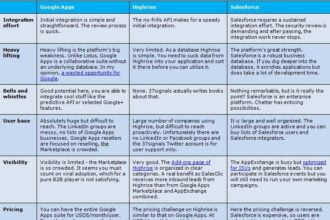Piggybacking off of the success of the most recent TEC Buyer’s Guide, the 2014 Buyer’s Guide on Mobile BI applications, we took the opportunity to survey users of mobile business intelligence (BI) applications and collect their impressions in regard to these tools. Most of the results of this survey with more than 250 respondents were captured in an Infographic. Additional information garnered from the survey, while not conclusive, may provide a glance into the sentiment of the respondents on their use of mobile BI applications. In this post, I’ll describe some of those results, which may be useful for those organizations evaluating a new mobile BI solution for their business needs. Most popular mobile BI apps The top 10 mobile BI apps in use are depicted in figure 1. Microsoft takes a clear lead, followed by the other big software powerhouses SAP, Oracle, and IBM. These results are in line with what we would expect considering that most of these vendors already have large sets of BI implementations worldwide and that customers tend to choose mobile BI offerings from their existing BI provider. Figure 1 shows that more than 8 percent of respondents either still have not implemented or are not using a mobile BI application. This is a relatively large segment of potential BI users, especially considering that most of the existing BI software providers now have mobile BI offerings, suggesting that it’s relatively effortless to put them in place. This apparent avoidance of mobile BI offerings within some organizations may stem from the following:
- Lack of use case for mobile BI apps
- Technical limitations to implementing a mobile BI app
- Budget restrictions
Other mobile BI offerings used in the organizations of the survey respondents come from QlikView, MicroStrategy, and Tableau—all great promoters of mobile offerings in the BI space, which are rapidly increasing their footprint in not only mobile BI, but also the mobile space overall. The remaining mobile BI offerings cited in our survey come the long-time and well-known BI player Information Builders; Infor, a traditional player in the enterprise resource planning (ERP) space which has been growing its BI presence; and, last but not least, an experienced BI player from the open-source community, Pentaho, which now has a robust mobile BI solution covering most, if not all, the aspects of an enterprise BI solution. Who’s using mobile BI and how? We also wanted to determine who is using mobile BI solutions and which mobile BI applications. When we took our top 10 provider list and segmented it in terms of the size of the company our survey respondents work for, some results became immediately apparent. Microsoft was by far the most widely used mobile BI solution by companies with 1 to 50 employees, while SAP was the most popular solution among companies with 51 to 100 employees (see figure 2). On the other hand, there seems to be healthy competition between the big four (IBM, SAP, Microsoft, and Oracle) in the large enterprise segment, with increased presence of other players such as Information Builders, MicroStrategy, QlikView, and Tableau.
Figure 2 shows that the most widely used mobile BI offerings are from Microsoft and SAP regardless of respondent’s company size—from small companies with 1 to 50 employees to large enterprises with more than 10,000 employees. These results may reflect the intense efforts both these vendors have undertaken to evolve their enterprise BI solutions with new mobile technologies and capabilities to enable customers to use mobile more seamlessly. If we look at the type of industry the respondents’ companies belong to, we can see that the top 10 industries in figure 3. The computer, IT, and software industry takes the lead in usage of mobile BI solutions, a field of course that typically spurs trends in technology adoption. Additionally, business services and consulting and manufacturing are in second and third place, respectively, followed by finance and banking in fourth place. All these industries are in my opinion justified in their need for mobile services, as are many of their lines of business. I have to admit that I was surprised to find hotels and restaurants in the top 10 industries using mobile BI offerings, not because there is no use case for mobile BI in that industry, but because there are other industries which according to previous research appear to be more amenable to the adoption of mobile BI solutions. Examples include utilities and service industries.
If we dig a little deeper and look at what mobile BI apps are used by the top 10 industries, we see that Microsoft still leads the pack with dominant presence in the hotels and restaurants industry, and in finance and banking. On the other hand, SAP shows a prominent dominance in hotels and restaurants, and in the finance and banking and manufacturing industries. It is noteworthy to mention that QlikView, among other vendors, has a strong presence in electronics and high-tech. Organizations in these areas typically have great technical expertise, attesting to QlikView’s technical and functional capabilities.
Additionally, Oracle shows mobile BI presence nearly across the board, from the software industry to electronics and banking. Furthermore, the three powerhouses Oracle, SAP, and Microsoft dominate the mobile BI usage in the insurance and finance and banking industries Conclusion Based on the results of our survey on mobile BI usage, we can see that the four main players—Microsoft, SAP, IBM and Oracle—are well positioned in the mobile BI market, pretty much inheriting success from their high-profile BI solutions. Other vendors such as Tableau, QlikView, MicroStrategy, and Information Builders are rapidly establishing themselves as major BI providers and making their presence known on the mobile BI stage. Though the information presented in this post can be considered neither conclusive nor extensive, it can be used as a good starting point or basic point of reference for gauging what mobile BI solutions your peers in companies with a similar size as yours and in the same industry are using. This information may be useful before you embark upon the venture of acquiring a new mobile BI solution or replacing the one you already have. Stay tuned for a second post on the survey, where I will present the most requested mobile BI functionality and the users’ level of satisfaction with their mobile BI offerings. Link to original article














